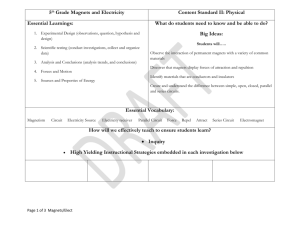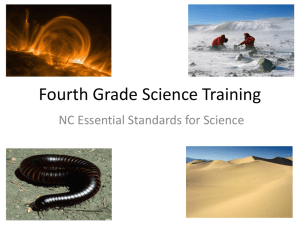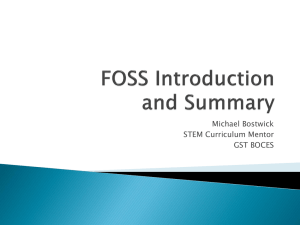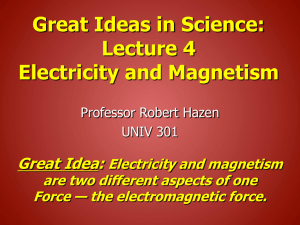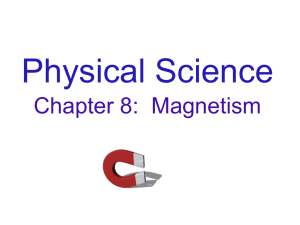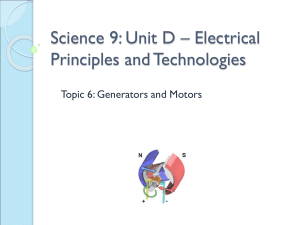OBJECTIVE - Newark Public Schools
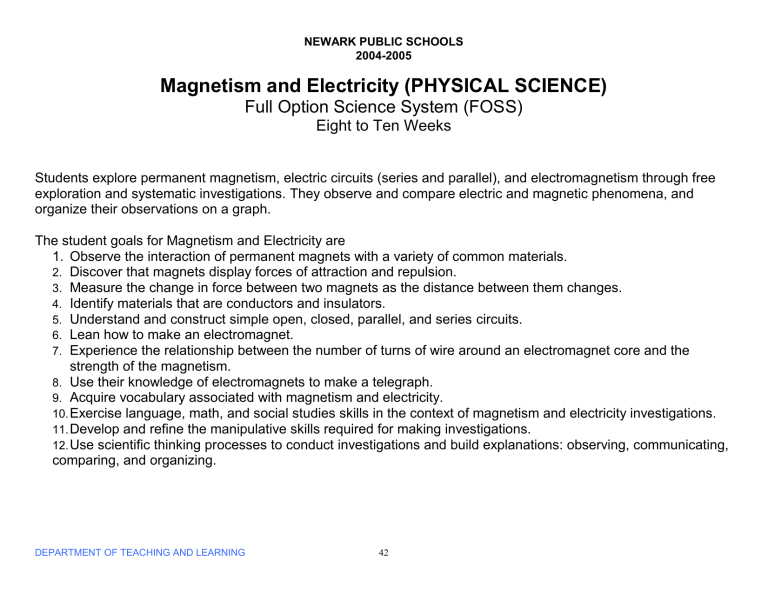
NEWARK PUBLIC SCHOOLS
2004-2005
Magnetism and Electricity (PHYSICAL SCIENCE)
Full Option Science System (FOSS)
Eight to Ten Weeks
Students explore permanent magnetism, electric circuits (series and parallel), and electromagnetism through free exploration and systematic investigations. They observe and compare electric and magnetic phenomena, and organize their observations on a graph.
The student goals for Magnetism and Electricity are
1. Observe the interaction of permanent magnets with a variety of common materials.
2.
3.
Discover that magnets display forces of attraction and repulsion.
Measure the change in force between two magnets as the distance between them changes.
4.
5.
6.
7.
Identify materials that are conductors and insulators.
Understand and construct simple open, closed, parallel, and series circuits.
Lean how to make an electromagnet.
Experience the relationship between the number of turns of wire around an electromagnet core and the
8. strength of the magnetism.
Use their knowledge of electromagnets to make a telegraph.
9. Acquire vocabulary associated with magnetism and electricity.
10. Exercise language, math, and social studies skills in the context of magnetism and electricity investigations.
11. Develop and refine the manipulative skills required for making investigations.
12. Use scientific thinking processes to conduct investigations and build explanations: observing, communicating, comparing, and organizing.
DEPARTMENT OF TEACHING AND LEARNING 42
NEWARK PUBLIC SCHOOLS
2004-2005
GOAL/OBJECTIVE : Students will experiment with magnets to examine the interaction of magnets with common materials,
discover magnetic force and measure the force of attraction between magnets.
ABACUS CORRELATED OBJECTIVE (S):
THEME/CONTENT
THEME:
Magnetic and
Electricity
(FOSS)
Investigation – 1:
The Force
CONTENT:
Magnets
Properties
Magnetism
Magnetic Forces
Induced magnetism
Temporary magnets
Graph
Intersection
STATE /
NATIONAL
STANDARDS
STATE
5.1
A 1, 2, 3, 4
B 1, 2
C 1, 2
5.3
B 1, 2
D 1
5.4
B 1
5.7
A 2
NATIONAL
A Inquiry
B Physical
E Technology
F Per. & Soc.
Perspective
G History and
Nature
ACTIVITIES
EXAMPLES OF THE TYPE OF WORK STUDENTS SHOULD
BE ABLE TO DO TO MEET THE STANDARDS AND
CUMULATIVE PROGRESS INDICATORS
Part 1:
Investigating Magnets and Materials
Use a magnet to detect objects that contain iron.
Explore magnetic interactions – attract and repel.
Record results and observations on student sheet 3.
Read FOSS Science Stories page 1 through 4.
Write glossary terms.
Part 2:
Investigating More Magnetic Properties
Explore how magnets interact with other objects.
Observe and share observations on induced magnetism and temporary magnets.
Work on Student Sheet 4.
Read FOSS Science Stories page 5
Part 3:
Breaking the Force
Investigate changes in the force of attraction between
2 magnets.
Measure the force of attraction between 2 magnets in relation to the distance between them.
Record data on graph, Student Sheet 4.
Part 4:
Detecting the Force of Magnetism
Explore ways to detect magnetic force, using compasses and iron filings.
Record results on Student Sheet 6.
Assessment: Teacher’s Guide – Investigation 1 - page 3
REFERENCES FOR
CROSS-CONTENT
CONNECTIONS /
TEACHER’S NOTES
Readings FOSS:
Part 1
Magnets Get Stuck
Part 2
Magnificent Magnetic
Modules.
Part 4
How Magnets interact.
Reference Readings:
What Makes A
Magnet – Franklin
Branley
Martas’ Magnets –
Wendy Pfeffer
Extension: Teacher’s
Guide – Investigation 1
- page 35 & 36.
LINKED
RESOURCES
MULTIMEDIA
BIBLIOGRAPHY
WEB LINKS
WEB: www.fosweb.com
GOAL/OBJECTIVE : Students will assemble circuits, identify flow of current & discover insulators & conductors.
DEPARTMENT OF TEACHING AND LEARNING 43
NEWARK PUBLIC SCHOOLS
2004-2005
ABACUS CORRELATED OBJECTIVE (S):
THEME/CONTENT STATE /
NATIONAL
STANDARDS
ACTIVITIES
EXAMPLES OF THE TYPE OF WORK STUDENTS
SHOULD BE ABLE TO DO TO MEET THE STANDARDS
AND CUMULATIVE PROGRESS INDICATORS
THEME:
Magnetic and
Electricity
(FOSS)
Investigation – 2:
Making
Connection
CONTENT:
D. Cell / battery
Electricity receiver
Circuits -
Closed, open
Filament
Insulators & conductors
Switch
Schematic charge
STATE
5.1
A 1, 2, 3, 4
B 1, 2
C 1, 2
5.2
A 1
B 1
5.3
D 1
5.4
B 1
C 1, 2
5.7
B 3
NATIONAL
A Inquiry
B Physical
E Technology
F Per. & Soc.
Perspective
G History and
Nature
Part 1:
Lighting A Bulb
Build and compare simple circuits.
Identify components of an electricity circuit.
Complete the circuit diagram and explanation on
Student Sheet 7 – The Flow of Electricity.
Part 2:
Making a Motor Run
Demonstrate and illustrate evidence of the flow of electricity.
Compare closed & open circuit – Response Sheet 9
Draw a Schematic diagram Student Sheet – 8
Complete Response Sheet - 9
Part 3:
Finding Insulation & Conductors
Build a circuit to identify conductors and insulators.
Read FOSS Science Stories page 8 & 9
Complete Student Sheet 10.
Part 4:
Investigating Mystery Circuits
Work with mystery boards to check for conductors and the flow of electricity through a circuit.
Work on Student Sheet 11 & 12.
Read FOSS Science Stories page 10
Assessment: Teacher’s Guide, Investigation – 2: page 3
REFERENCES FOR
CROSS-CONTENT
CONNECTIONS /
TEACHER’S NOTES
Readings FOSS:
Part 3
Making Static.
Benjamin Franklin.
Part 4
Two Reference
Sources about
Edison.
Reference Readings:
Discovering Electricity
– Rae Bains
Extension: Teacher’s
Guide – Investigation 2
- page 30, 31, 32
LINKED
RESOURCES
MULTIMEDIA
BIBLIOGRAPHY
WEB LINKS
WEB: www.fosweb.com
VIDEO
Benjamin
Franklin. –
Scientist &
Inventor.
Thomas Edison & the Electric Light.
GOAL/OBJECTIVE : Students will assemble and compare series & parallel circuits, and test different circuit designs.
DEPARTMENT OF TEACHING AND LEARNING 44
ABACUS CORRELATED OBJECTIVE (S):
THEME/CONTENT
THEME:
Magnetic and
Electricity
(FOSS)
Investigation – 3
Advanced
Connections.
CONTENT:
Circuits:
Series
Parallel
Components
STATE /
NATIONAL
STANDARDS
STATE
5.1
A 1, 2, 3, 4
B 1, 2
C 1, 2
5.3
D 1
5.4
B 1
C 1, 2
5.7
B 3
NATIONAL
A Inquiry
B Physical
E Technology
F Per. & Soc.
Perspective
G History and
Nature
NEWARK PUBLIC SCHOOLS
2004-2005
ACTIVITIES
EXAMPLES OF THE TYPE OF WORK STUDENTS
SHOULD BE ABLE TO DO TO MEET THE STANDARDS
AND CUMULATIVE PROGRESS INDICATORS
Part 1:
Building Series Circuits
Find ways to operate more than one component in a circuit.
Assemble a series circuit to make 2 bulbs shine brightly with 2 D Cells.
Record reasons on Student Sheet 15
Read FOSS Science Stories pages 12 through 15.
Part 2:
Building Parallel Circuits
Find another way to operate two components in a circuit.
Assemble a parallel circuit to make 2 bulbs glow with
1 D Cell.
Record Reasons on Student Sheet 15
Complete Response Sheet - 16
Read FOSS Science Stories page 16.
Part 3:
Solving the String of Lights Problem:
Simulate the research and development department of decorative light manufacturers.
Test circuit designs.
Build long strings of light.
Complete Student Sheet 17
Assessment: Teacher’s Guide Investigation 3 - page 3
REFERENCES FOR
CROSS-CONTENT
CONNECTIONS /
TEACHER’S NOTES
Readings FOSS:
Part 1
Illuminating Team
Work
Part 2
A true Pioneer
Latimer Lewis
Howard
Reference Readings:
Electricity – John &
Janet Clemence
Extension: Teacher’s
Guide – Investigation 3
- page 27 & 28
LINKED
RESOURCES
MULTIMEDIA
BIBLIOGRAPHY
WEB LINKS
WEB: www.fosweb.com
GOAL/OBJECTIVE : Students will construct an electromagnet; examine the effect of the turns of the wire on the strength
DEPARTMENT OF TEACHING AND LEARNING 45
NEWARK PUBLIC SCHOOLS
2004-2005
of the magnet. Students will design and conduct an experiment to discover other ways to develop the
strength of an electromagnet.
ABACUS CORRELATED OBJECTIVE (S):
THEME/CONTENT
THEME:
Magnetic and
Electricity
(FOSS)
Investigation – 4
Current Attractions
CONTENT:
Circuits:
Electromagnet and
Electromagnetism.
Core.
Coil.
Changing the strength of an electromagnet.
STATE /
NATIONAL
STANDARDS
STATE
5.1
A 1, 2, 3, 4
B 1, 2
C 1, 2
5.3
B 1
D 1
5.4
B 1
C 1, 2
5.7
A 2
B 3
NATIONAL
A Inquiry
B Physical
E Technology
F Per. & Soc.
Perspective
G History and
Nature
ACTIVITIES
EXAMPLES OF THE TYPE OF WORK STUDENTS
SHOULD BE ABLE TO DO TO MEET THE STANDARDS
AND CUMULATIVE PROGRESS INDICATORS
Part 1:
Building an Electromagnet
Discover that when current flows through an insolated wire wound around a steel core, the steel core becomes a magnet.
Find the placement of the wire on the rivet that makes the strongest electromagnet.
Read FOSS Science Stories page 17 through 19.
Part 2:
Changing Number of Winds
Experiment to find the relation between the number of turns of wire and the strength of the magnet.
Graph, and predict the results on Student Sheet –
18
Complete Response Sheet – 19.
Read FOSS Science Stories page 20 through 23.
Part 3:
Investigating More Electromagnets
Investigate other ways to change the strength of an electromagnet.
Design & conduct an experiment.
Read FOSS Science Stories page 24 & 25.
Record answers on Student Sheet 20.
Assessment: Teacher’s Guide – Investigation 4 page 3
REFERENCES FOR
CROSS-CONTENT
CONNECTIONS /
TEACHER’S NOTES
Readings FOSS:
Part 1
From Rags to
Science – Michael
Faraday.
Part 2
How Electro
Magnetism stopped a war.
Part 3
Magnets and electricity in your life.
Reference Readings:
Electricity &
Magnetism – Peter
Adamczyk & Paul
Francis Law
Extension: Teacher’s
Guide Investigation 4 page 23
LINKED
RESOURCES
MULTIMEDIA
BIBLIOGRAPHY
WEB LINKS
WEB: www.fosweb.com
GOAL/OBJECTIVE : Students will apply knowledge of circuitry and electromagnets to assemble a telegraph that helps to communicate.
DEPARTMENT OF TEACHING AND LEARNING 46
ABACUS CORRELATED OBJECTIVE (S):
THEME/CONTENT
THEME:
Magnetic and
Electricity
(FOSS)
Investigation – 5
Click It.
CONTENT:
Circuits:
Technology
Telegraph
Code
STATE /
NATIONAL
STANDARDS
NEWARK PUBLIC SCHOOLS
2004-2005
ACTIVITIES
EXAMPLES OF THE TYPE OF WORK STUDENTS
SHOULD BE ABLE TO DO TO MEET THE STANDARDS
AND CUMULATIVE PROGRESS INDICATORS
STATE
5.1
A 1, 2, 3, 4
B 1, 2
C 1, 2
5.3
B 1
D 1
5.4
B 1
C 1, 2
5.7
A 2
B 3
NATIONAL
A Inquiry
B Physical
E Technology
F Per. & Soc.
Perspective
G History and
Nature
Part 1:
Reinventing the Telegraph.
Build a telegraph.
Share experience.
Invent a code.
Use then telegraph to send a single word message.
Use Student Sheet 21.
Part 2:
Sending Messages
Connect two telegraphs to communicate with one another.
Develop procedural codes.
Use Student Sheet 22.
Read FOSS Science Stories page 26 through 29.
Part 3:
Choosing Your Own Investigation:
Review magnet and electricity.
Identify, design & conduct an investigation.
Present results of the project.
Assessment: Teacher’s Guide investigation 5 page 3
REFERENCES FOR
CROSS-CONTENT
CONNECTIONS /
TEACHER’S NOTES
Readings FOSS:
Part 2
Horse Gets Clicking
- Samuel Horse
Reference Readings:
Experiments With
Magnets – Helen J.
Challand
Reference Readings:
Electricity – John &
Janet Clemence
Extension: Teacher’s
Guide investigation – 5 page 26 & 27
LINKED
RESOURCES
MULTIMEDIA
BIBLIOGRAPHY
WEB LINKS
WEB: www.fosweb.com
DEPARTMENT OF TEACHING AND LEARNING 47
